

Adlet. Amarok (wolf) Amarok (or Amaroq) is the name of a gigantic wolf in Inuit mythology.

It is said to hunt down and devour anyone foolish enough to hunt alone at night. Unlike real wolves who hunt in packs, Amarok hunts alone. It is sometimes considered equivalent to the waheela of cryptozoology. [citation needed] See also Amaguq; a trickster and wolf god. In Tales and Traditions of the Eskimo, Hinrich Rink recounts several folk legends that feature the amarok. [1] Some notable tales include: A persecuted and physically-stunted young boy sought to increase his strength. Rink recounts other tales where an amarok was killed or captured by a human. [1]:215,249,438,457,470. Rink claims that native Greenlanders use the term "amarok" to describe a large, "fabulous" animal, whereas other Arctic peoples use the term to describe refer to a wolf[1]:48.
Anubis. Anubis (/əˈnuːbəs/ or /əˈnjuːbəs/;[2] Ancient Greek: Ἄνουβις) is the Greek name[3] for a jackal-headed god associated with mummification and the afterlife in ancient Egyptian religion.
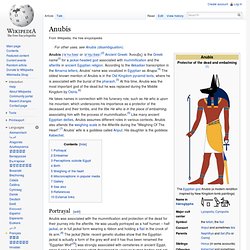
According to the Akkadian transcription in the Amarna letters, Anubis' name was vocalized in Egyptian as Anapa.[4] The oldest known mention of Anubis is in the Old Kingdom pyramid texts, where he is associated with the burial of the pharaoh.[5] At this time, Anubis was the most important god of the dead but he was replaced during the Middle Kingdom by Osiris.[6] He takes names in connection with his funerary role, such as He who is upon his mountain, which underscores his importance as a protector of the deceased and their tombs, and the title He who is in the place of embalming, associating him with the process of mummification.[5] Like many ancient Egyptian deities, Anubis assumes different roles in various contexts. Portrayal[edit] Embalmer[edit]
Asena. Asena is the name of a she-wolf [1][2][3] associated with a Göktürk ethnogenic myth "full of shamanic symbolism.
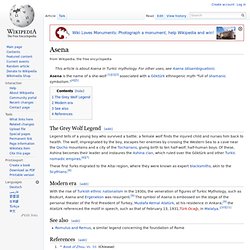
"[4][5] The Grey Wolf Legend[edit] These first Turks migrated to the Altai region, where they were known as expert blacksmiths, akin to the Scythians.[8] Axehandle hound. An illustration of an axehandle hound.
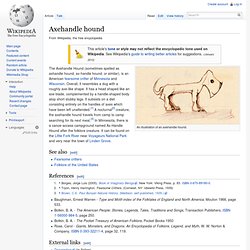
The Axehandle Hound (sometimes spelled as axhandle hound, ax-handle hound, or similar), is an American fearsome critter of Minnesota and Wisconsin. Overall, it resembles a dog with a roughly axe-like shape. It has a head shaped like an axe blade, complemented by a handle-shaped body atop short stubby legs. It subsists on a diet consisting entirely on the handles of axes which have been left unattended.[1] A nocturnal[2] creature, the axehandle hound travels from camp to camp searching for its next meal.[3] In Minnesota, there is a canoe-access campground named Ax-Handle Hound after the folklore creature. It can be found on the Little Fork River near Voyageurs National Park and very near the town of Linden Grove. See also[edit] Beast of Gévaudan. The Beast of Gévaudan (French: La Bête du Gévaudan; IPA: [la bɛːt dy ʒevodɑ̃], Occitan: La Bèstia de Gavaudan) is the historical name associated with the man-eating wolf-like animals which terrorised the former province of Gévaudan (modern-day département of Lozère and part of Haute-Loire), in the Margeride Mountains in south-central France between 1764 and 1767.[2] The attacks, which covered an area stretching 90 by 80 kilometres (56 by 50 mi), were said to have been committed by beasts that had formidable teeth and immense tails according to contemporary eye-witnesses.
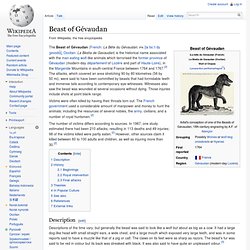
Witnesses also saw the beast was wounded at several occasions without dying. Those injuries include shots at point blank range. Victims were often killed by having their throats torn out. Black dog (ghost) The origins of the black dog are difficult to discern.
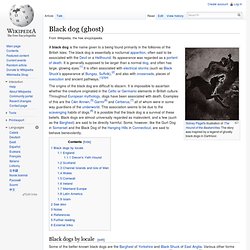
It is impossible to ascertain whether the creature originated in the Celtic or Germanic elements in British culture. Throughout European mythology, dogs have been associated with death. Cerberus. Cerberus /ˈsɜrbərəs/,[1] or Kerberos, (Greek form: Κέρβερος, [ˈkerberos])[2] in Greek and Roman mythology, is a multi-headed (usually three-headed) dog, or "hellhound" [1][3][4] with a serpent's tail, a mane of snakes, and a lion's claws.[5] He guards the entrance of the underworld to prevent the dead from escaping and the living from entering.

Cerberus is featured in many works of ancient Greek and Roman literature and in works of both ancient and modern art and architecture, although the depiction of Cerberus differs across various renditions. The most notable difference is the number of his heads: Most sources describe or depict three heads; others show Cerberus with two or even just one; a smaller number of sources show a variable number, sometimes as many as 50 or even 100. Chupacabra. The chupacabra (Spanish pronunciation: [tʃupaˈkaβɾa], from chupar "to suck" and cabra "goat", literally "goat sucker") is a legendary cryptid rumored to inhabit parts of the Americas, with the first sightings reported in Puerto Rico.
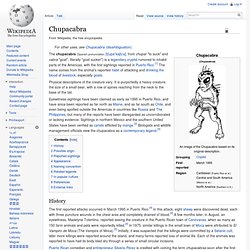
Crocotta. Crocotta, as illustrated in a medieval bestiary Not to be confused with Corocotta, Cantabrian guerrilla or bandit.
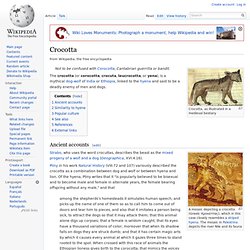
The crocotta (or corocotta, crocuta, leucrocotta, or yena), is a mythical dog-wolf of India or Ethiopia, linked to the hyena and said to be a deadly enemy of men and dogs. Cù Sìth. The Cù-Sìth (Scottish Gaelic pronunciation: [kuː ʃiː]), plural Coin-Sìth (Scottish Gaelic pronunciation: [kɔːn ʃiː]) is a mythological hound found in Scotland and the Hebrides.
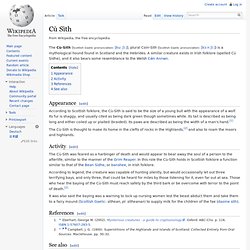
A similar creature exists in Irish folklore (spelled Cú Sídhe), and it also bears some resemblance to the Welsh Cŵn Annwn. Appearance[edit] According to Scottish folklore, the Cù-Sìth is said to be the size of a young bull with the appearance of a wolf. Its fur is shaggy, and usually cited as being dark green though sometimes white. Its tail is described as being long and either coiled up or plaited (braided). Cynocephaly. The characteristic of cynocephaly, having the head of a dog—or of a jackal—is a widely attested mythical phenomenon existing in many different forms and contexts. Etymology[edit] Ancient Greece and Egypt[edit] As George Alexandrou has pointed out, "in this northeast region of Pakistan, and we know that there were peoples in this area who slashed their cheeks from mouth to ear, so that all the teeth showed. Marco Polo saw this tribe, whom he called the Cynocefaloi. He said that they looked like mastiffs; that is, they didn’t have elongated heads like German shepherds with the long nose, but like mastiffs.
Fenrir. Odin and Fenris (1909) by Dorothy Hardy In Norse mythology, Fenrir (Old Norse: "fen-dweller"),[1] Fenrisúlfr (Old Norse: "Fenris wolf"),[2] Hróðvitnir (Old Norse: "fame-wolf"),[3] or Vánagandr (Old Norse: "the monster of the river Ván")[4] is a monstrous wolf. Fenrir is attested in the Poetic Edda, compiled in the 13th century from earlier traditional sources, and the Prose Edda and Heimskringla, written in the 13th century by Snorri Sturluson. In both the Poetic Edda and Prose Edda, Fenrir is the father of the wolves Sköll and Hati Hróðvitnisson, is a son of Loki, and is foretold to kill the god Odin during the events of Ragnarök, but will in turn be killed by Odin's son Víðarr.
In the Prose Edda, additional information is given about Fenrir, including that, due to the gods' knowledge of prophecies foretelling great trouble from Fenrir and his rapid growth, the gods bound him, and as a result Fenrir bit off the right hand of the god Týr. Hellhound. A hellhound is a supernatural dog in folklore. A wide variety of ominous or hellish supernatural dogs occur in mythologies around the world, similar to the oft-seen dragon. Features that have been attributed to hellhounds include black fur, glowing red - or sometimes yellow - eyes, super strength or speed, ghostly or phantom characteristics, foul odor, and sometimes even the ability to talk. Certain European legends state that if someone stares into a hellhound's eyes three times or more, that person will surely die. In cultures that associate the afterlife with fire, hellhounds may have fire-based abilities and appearance. Huli jing. Huli jing (Chinese: 狐狸精; pinyin: húli jīng; literally: "fox spirit") in Chinese mythology are fox spirits that are akin to European fairies.
Huli jing can be either good spirits or bad spirits. In mythology[edit] In Chinese mythology, it is believed that all things are capable of acquiring human forms, magical powers, and immortality, provided that they receive sufficient energy, in such forms as human breath or essence from the moon and the sun. The fox spirits encountered in tales and legends are usually females and appear as young, beautiful women. Inugami. Inugami (犬神? , lit. Japanese raccoon dog. Kishi (folklore) The kishi is a two-faced demon in Angola. According to legend, a kishi has an attractive human man's face on the front of its body and a hyena's face on the back. Orthrus. Orthrus (Orthros) or Orthus (Orthos) (Greek: Ὄρθρος; Ὄρθος) was a two-headed dog in Greek mythology. Penghou. "Houkou" redirects here. It is not to be confused with Hukou.
Set animal. Shug Monkey. Shunka Warakin. The Shunka Warakin (also shunka warak'in) is an animal mentioned in American folklore that is said to resemble a wolf, a hyena, or both. According to cryptozoologist Loren Coleman, shunka warak'in is an Ioway term meaning "carries off dogs".[1] Coleman suggested that the creature was some animal unknown to modern sources. An animal shot in 1886 by Israel Ammon Hutchins on what is now the Sun Ranch in Montana[2] has been suggested by Coleman as an example of this mysterious creature.
Werehyena. Werewolf.